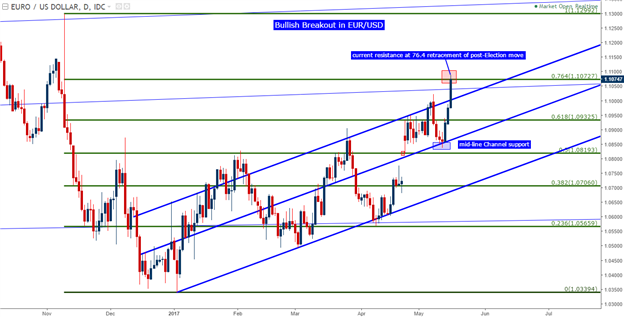EUR/USDÂ Jumps Past 1.1000
One of the few high-impact data releases for the week took place this morning, as Euro-Zone Q1 GDP printed in-line with expectations at .5% quarter-over-quarter and 1.7% year-over-year. But judging by price action, quite a bit more than just an in-line print is going on here as the Euro is rampantly running higher against most major currencies.

Chart prepared by James Stanley
On Friday of last week we looked at EUR/USD support around 1.0850. As of this morning, EUR/USD is more than 200 pips higher with very little pullback in the move.

Chart prepared by James Stanley
While it would be simple to ascribe this move as being directly related to Europe’s continued improvement on the economic data front, there is likely a bit more going on here. Namely, this further improvement in Euro data indicates that more stimulus is probably not in the pipeline for the European Central Bank after the current program expires in December of this year. So, as we get better and better data prints, investors are motivated to close-up short-Euro positions; and this in-turn brings on buying demand from short-cover. Given the subdued down-side reaction to the prior couple of weeks’ efforts from the ECB, and this would make logical sense: As European data improves, markets are growing increasingly optimistic that the ECB will not need to embark on another round of QE, so as the ECB tries to talk down the currency, the reaction is somewhat mitigated as market participants try to look beyond those assurances to see ‘what’s around the next corner’.
U.K. Inflation Hits 3-Year High
We’ve been discussing the prospect of higher-than-wanted levels of inflation in the U.K. since shortly after last year’s Brexit referendum: When a major currency drops 20 or 30% in a short period of time, as the British Pound did around Brexit, prices will likely begin to go up on imported products as producers try to avoid or offset diminishing margins. Mark Carney even warned us about this well-ahead of the Brexit referendum, saying that decision to leave the EU would entail slower growth, higher rates of unemployment, higher rates of inflation and a ‘sharp repricing’ in the value of the British Pound. This puts the Central Bank in an unenviable position: Do they cut rates to try to create stronger growth and lower levels of employment, even if at the behest of inflation; or do they hike rates to try to stem inflation while letting employment and growth languish?

